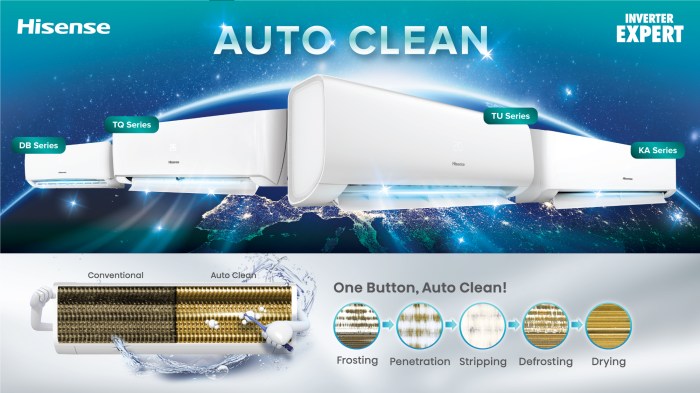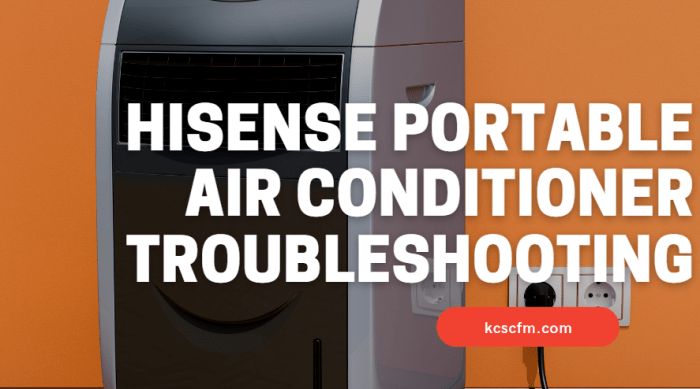Hisense Air Conditioner Guide: Setup, Features, Troubleshooting
Delving into Hisense Air Conditioner Guide: Setup, Features, Troubleshooting, this introduction immerses readers in a unique and compelling narrative, with a casual formal language style that is both engaging and thought-provoking from the very first sentence.
As we explore the world of Hisense Air Conditioners, we uncover the intricacies of setting up, discovering key features, and troubleshooting common issues that users may encounter.
Hisense Air Conditioner Setup
When setting up your Hisense air conditioner, it’s essential to follow a step-by-step process to ensure optimal performance and efficiency. Here is a guide to help you through the setup process.
Step-by-Step Setup Process
- Unbox your Hisense air conditioner and remove all packaging materials.
- Place the air conditioner near a power outlet and ensure there is proper ventilation around the unit.
- Install the mounting bracket securely on the wall according to the manufacturer’s instructions.
- Mount the air conditioner on the bracket and make sure it is level.
- Connect the exhaust hose to the back of the unit and route it through a window or opening for proper ventilation.
- Plug in the air conditioner and turn it on to test if it is working correctly.
Tools Required
For a successful setup of your Hisense air conditioner, you will need the following tools:
- Screwdriver
- Level
- Tape measure
- Mounting bracket kit (usually included with the air conditioner)
Optimizing Air Conditioner Positioning
Positioning your air conditioner correctly can greatly impact its efficiency. Here are some tips to optimize the positioning within a room:
- Place the air conditioner on the shady side of the room to reduce heat intake.
- Avoid placing the unit near sources of heat or direct sunlight.
- Ensure there is proper airflow around the air conditioner for efficient operation.
- Consider using curtains or blinds to block out sunlight and reduce the workload on the air conditioner.
Key Features of Hisense Air Conditioners

When it comes to Hisense air conditioners, there are several key features that set them apart from other brands in the market. From energy efficiency ratings to smart functionalities, Hisense offers a range of options to suit different needs.
Energy Efficiency Ratings
Hisense air conditioners are known for their high energy efficiency ratings, which can help you save on your electricity bills while still keeping your space cool and comfortable. The brand offers a variety of models with different energy ratings to choose from, ensuring that you can find one that fits your budget and environmental concerns.
Smart Functionalities
Some select Hisense air conditioners come equipped with smart functionalities, allowing you to control your cooling system remotely through a mobile app or voice commands. This feature not only adds convenience to your daily life but also enables you to adjust the settings based on your schedule or preferences, even when you’re not at home.
Troubleshooting Common Issues

When using your Hisense air conditioner, you may encounter some common issues that can affect its performance. It is essential to troubleshoot these problems to ensure your air conditioner works efficiently and effectively. In this guide, we will discuss some of the common problems faced by Hisense air conditioner users and how to resolve them.
Cleaning and Maintaining Air Filters
One of the most common issues with air conditioners is dirty or clogged air filters. Dirty filters can restrict airflow and reduce the cooling efficiency of your unit. To maintain optimal performance, it is essential to clean or replace the air filters regularly.
Here’s how you can clean the air filters of your Hisense air conditioner:
- Turn off the air conditioner and unplug it from the power source.
- Locate the air filters, usually found behind the front grille of the unit.
- Remove the filters and gently clean them with a soft brush or vacuum cleaner to remove dust and debris.
- If the filters are heavily soiled, you may need to wash them with mild soap and water, ensuring they are completely dry before reinstalling.
- Once the filters are clean, reinsert them back into the unit and secure the front grille.
- Plug in the air conditioner and turn it on to enjoy improved airflow and cooling efficiency.
Error Codes and Meanings
Hisense air conditioners may display error codes on their control panel to indicate specific issues or malfunctions. Understanding these error codes can help you troubleshoot problems effectively. Here are some common Hisense air conditioner error codes and their meanings:
| Error Code | Meaning |
|---|---|
| E1 | Indicates a communication error between the indoor and outdoor units. |
| E2 | Signals a temperature sensor error or malfunction. |
| E3 | Points to an issue with the indoor fan motor or blower. |
| E4 | Denotes a problem with the outdoor fan motor or blower. |
| E5 | Alerts to a refrigerant leakage or low pressure in the system. |
Closing Summary

In conclusion, this comprehensive guide to Hisense Air Conditioners leaves no stone unturned, offering valuable insights into the setup, features, and troubleshooting techniques. Dive into the world of Hisense and experience efficient cooling like never before.
Popular Questions
What tools are needed for setting up a Hisense air conditioner?
Common tools required for setting up a Hisense air conditioner include a screwdriver, level, and measuring tape.
How can I optimize the positioning of my Hisense air conditioner for better performance?
Ensure that the air conditioner is placed away from direct sunlight and heat sources for optimal cooling efficiency.
What are some unique features of Hisense air conditioners?
Hisense air conditioners are known for their smart functionalities, energy efficiency ratings, and sleek designs that set them apart from other brands.